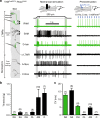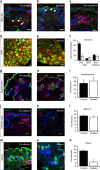Control of mechanical pain hypersensitivity in mice through ligand-targeted photoablation of TrkB-positive sensory neurons
- PMID: 29691410
- PMCID: PMC5915601
- DOI: 10.1038/s41467-018-04049-3
Control of mechanical pain hypersensitivity in mice through ligand-targeted photoablation of TrkB-positive sensory neurons
Abstract
Mechanical allodynia is a major symptom of neuropathic pain whereby innocuous touch evokes severe pain. Here we identify a population of peripheral sensory neurons expressing TrkB that are both necessary and sufficient for producing pain from light touch after nerve injury in mice. Mice in which TrkB-Cre-expressing neurons are ablated are less sensitive to the lightest touch under basal conditions, and fail to develop mechanical allodynia in a model of neuropathic pain. Moreover, selective optogenetic activation of these neurons after nerve injury evokes marked nociceptive behavior. Using a phototherapeutic approach based upon BDNF, the ligand for TrkB, we perform molecule-guided laser ablation of these neurons and achieve long-term retraction of TrkB-positive neurons from the skin and pronounced reversal of mechanical allodynia across multiple types of neuropathic pain. Thus we identify the peripheral neurons which transmit pain from light touch and uncover a novel pharmacological strategy for its treatment.
Conflict of interest statement
The authors declare no competing interests.
Figures







Similar articles
-
Is Optogenetic Activation of Vglut1-Positive Aβ Low-Threshold Mechanoreceptors Sufficient to Induce Tactile Allodynia in Mice after Nerve Injury?J Neurosci. 2019 Jul 31;39(31):6202-6215. doi: 10.1523/JNEUROSCI.2064-18.2019. Epub 2019 May 31. J Neurosci. 2019. PMID: 31152125 Free PMC article.
-
Receptor dependence of BDNF actions in superficial dorsal horn: relation to central sensitization and actions of macrophage colony stimulating factor 1.J Neurophysiol. 2019 Jun 1;121(6):2308-2322. doi: 10.1152/jn.00839.2018. Epub 2019 Apr 17. J Neurophysiol. 2019. PMID: 30995156
-
Optogenetic Inhibition of CGRPα Sensory Neurons Reveals Their Distinct Roles in Neuropathic and Incisional Pain.J Neurosci. 2018 Jun 20;38(25):5807-5825. doi: 10.1523/JNEUROSCI.3565-17.2018. J Neurosci. 2018. PMID: 29925650 Free PMC article.
-
Microglia in Neuropathic Pain.Adv Neurobiol. 2024;37:399-403. doi: 10.1007/978-3-031-55529-9_22. Adv Neurobiol. 2024. PMID: 39207704 Review.
-
New approach for investigating neuropathic allodynia by optogenetics.Pain. 2019 May;160 Suppl 1:S53-S58. doi: 10.1097/j.pain.0000000000001506. Pain. 2019. PMID: 31008850 Review.
Cited by
-
Peripheral mechanisms of peripheral neuropathic pain.Front Mol Neurosci. 2023 Sep 14;16:1252442. doi: 10.3389/fnmol.2023.1252442. eCollection 2023. Front Mol Neurosci. 2023. PMID: 37781093 Free PMC article. Review.
-
The Role of TRESK in Discrete Sensory Neuron Populations and Somatosensory Processing.Front Mol Neurosci. 2019 Jul 17;12:170. doi: 10.3389/fnmol.2019.00170. eCollection 2019. Front Mol Neurosci. 2019. PMID: 31379497 Free PMC article.
-
A machine-vision approach for automated pain measurement at millisecond timescales.Elife. 2020 Aug 6;9:e57258. doi: 10.7554/eLife.57258. Elife. 2020. PMID: 32758355 Free PMC article.
-
Is Optogenetic Activation of Vglut1-Positive Aβ Low-Threshold Mechanoreceptors Sufficient to Induce Tactile Allodynia in Mice after Nerve Injury?J Neurosci. 2019 Jul 31;39(31):6202-6215. doi: 10.1523/JNEUROSCI.2064-18.2019. Epub 2019 May 31. J Neurosci. 2019. PMID: 31152125 Free PMC article.
-
Defining a Spinal Microcircuit that Gates Myelinated Afferent Input: Implications for Tactile Allodynia.Cell Rep. 2019 Jul 9;28(2):526-540.e6. doi: 10.1016/j.celrep.2019.06.040. Cell Rep. 2019. PMID: 31291586 Free PMC article.
References
Publication types
MeSH terms
Substances
Grants and funding
LinkOut - more resources
Full Text Sources
Other Literature Sources
Molecular Biology Databases
Research Materials

